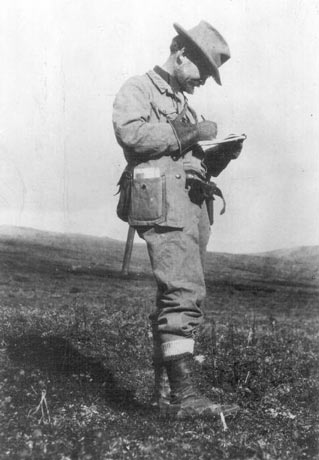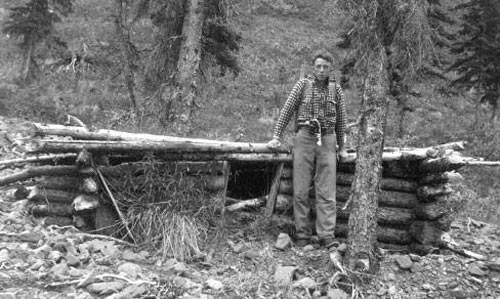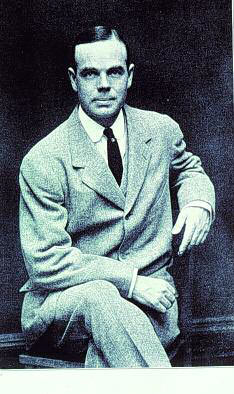(Adolf Murie’s) observation and study of the grizzly bear prompted him to comment that “...wild grizzlies in McKinley National Park, conducting their affairs undisturbed, are the essence of wilderness spirit..."

U.S. Geological Survey photograph, Portraits #246
Denali National Park and Preserve has a long and interesting history of scientific research. Beginning with research by the U.S. Geological Survey (USGS), scientific studies have been carried out for over 100 years, helping officials manage the park and educating the public about park resources.
As early as 1902, USGS geologist Alfred Brooks began studies of the northern foot-hills of Denali. With the discovery of gold in the Kantishna Hills, the USGS intensified its efforts in the region with geological surveys. Geologist Stephen R. Capps spent many seasons in Kantishna, studying and reporting on mining activity. He was instrumental in the movement to establish Mt. McKinley National Park when he wrote an article for the January 1917 issue of National Geographic Magazine. His article reported that large numbers of game animals were being taken by market hunters, supporting the conservation argument of Charles Sheldon and others. Geological studies and reports of the Kantishna Hills by the USGS continued until the 1970s.
Wildlife studies and observations by Charles Sheldon in 1907-08 began the long tradition of wildlife research and conservation in the park. Sheldon’s work resulted in the identification of 23 different mammals and 32 species of birds. His diary, published as The Wilderness of Denali, was the earliest study of the natural habitat in Denali (Dixon 1938).
Wildlife research in the park began in earnest when Dr. Olaus Murie of the U.S. Biological Survey arrived in the early 1920s to study caribou. In 1922, Adolph Murie joined his brother, researching and writing about the mammals and birds, as well as many other aspects of the ecology. Adolph’s association and work in the park would continue until the early 1970s.
Other scientists arrived in 1926 to conduct animal population surveys and examine the dynamics between the various animals in the park. Research by George Wright and Joseph Dixon comprised the first “comprehensive, ecologically based survey of the park” (Brown 1991). Wright and Dixon recorded 86 species of birds and 25 different mammals. Their research collections included 168 bird specimens, 83 mammal study skins, 350 photographs, and 280 pages of field notes (Dixon 1938). Dixon returned to the park in 1932 to complete the 1926 study, resulting in his book, Birds and Mammals of Mount McKinley National Park, Alaska (1938).

NPS photograph, Denali National Park and Preserve Archives #4.
During the first 20 years of the park’s existence, studies of large mammals concentrated on caribou, Dall sheep, and wolves. The early studies investigated the effects of interbreeding between caribou and local reindeer populations, as well as the size and movement of caribou herds.
Adolph Murie continued the caribou studies in the late 1930s and early 1940s, when he recorded rutting and calving behavior and the sex and age composition of the herds. He tracked caribou numbers through 1965. In the late 1960s, aerial surveys were used to study seasonal movement and record population statistics.
These survey practices increasingly were supplemented with radio collaring, which is the technique used today. Results of these important studies of the caribou population led to studies of other mammals in the park. A significant decline in the Dall sheep population in the late 1920s and early 1930s led the NPS to institute a limited wolf control program.
In 1939, Murie began to study the predator/prey relationship of wolves and Dall sheep, and he determined that the decline resulted from unusually harsh winters, rather than wolf predation. Murie’s conclusion led the NPS to end the wolf control program at Denali. However, by 1945 the sheep population was again very low. With the support of the scientific and wildlife conservation communities and in order to avoid legislation forcing rigid wolf control, the NPS instituted a limited wolf control program in 1945 and suspended the program by 1952 when the sheep population recovered.
Murie’s study of the predator/prey relationship, published in 1944 as The Wolves of Mount McKinley, provides detailed information on wolves, and also includes Dall sheep, caribou, moose, grizzly bears, fox, and eagles. In the late 1950s, Murie began a focused study of the grizzly bear population in the park that would last ten years.
Murie gathered data regarding the life cycle, feeding habits, and range of the grizzly bear. His observation and study of the grizzly bear prompted him to comment that “...wild grizzlies in McKinley National Park, conducting their affairs undisturbed, are the essence of wilderness spirit...” (Murie 1981). The observation of grizzlies in their natural habitat continues to be a main attraction in Denali. Although the most noted wildlife studies centered around wolves, sheep, caribou, and bears, scientists studied these large mammals in the context of the entire ecosystem.
Observations and information gathered on moose, small mammals, birds, insects, and plants all add to our understanding of the natural dynamics. In 1980, Victor Van Ballenberghe began studying the moose population, a study that continues to the present (see article this issue). In the last 20 years, wildlife research has expanded to include studies of small mammals, such as voles and ground squirrels, and bird research also increased.
Wolf studies have continued, with Gordon Haber studying and observing two wolf packs from 1966 to 1974. Wildlife biologists L. David Mech, Layne Adams, John W. Burch, Thomas J. Meier, and Bruce W. Dale began a comprehensive wolf study in 1986 (see Meier et al. article, this issue). This team detailed their wolf-caribou findings in The Wolves of Denali, published in 1998. Observations and information gathered by many of the wildlife scientists included data on the flora of the park. In addition, several focused botanical studies have occurred.
The first study of vegetation took place when Inez Mexia and Frances Payne of the University of California collected wildflowers and shrubs in 1927. The best known vegetation study occurred in the 1930s when Dr. Aven Nelson and Ruth Ashton Nelson of the University of Wyoming collected and classified plant growth for the Museum of London and the Smithsonian Institution. Their significant contribution regarding the study of vegetation resulted in the NPS identifying hundreds of plants within the park boundary.

NPS Photo, Denali National Park and Preserve Archives #1966
Botanist Leslie A. Viereck studied plant succession and soil development on the outwash of the Muldrow Glacier in the early 1960s. The plots used by Viereck are currently being revisited and studied by NPS botanists as part of a comparative, long-range study. Viereck and others worked to develop the Alaska vegetation classification system and published Alaska Trees and Shrubs in 1972.
Vegetation studies continued in the 1970s and 1980s. Frederick C. Dean’s botanical work was part of the studies conducted concerning the effects of development on the Denali wilderness. Dean provided the park with a mapping study of vegetation and an analysis of the effects of trampling on park vegetation (Dean 1979, 1982).
Denali itself was and is the site for numerous research projects. As early as 1932, scientific research on Mount McKinley began with the study of cosmic radiation at high altitudes. Following this work, the U.S. Army tested cold weather equipment on the mountain. Studies of glacier movement, geological specimens, and weather data are a few of the other research projects undertaken on the mountain. Even testing the effect of high altitude and extreme cold on photographic and motion picture equipment has taken place on the mountain. These research projects and current medical research provide a wealth of scientific information both about the mountain and the effects of high altitude and cold.
Independent investigations early on provided a foundation for development of the ecosystem study framework that allows for more accurate interpretation of scientific data. In more recent years, the Inventory and Monitoring Program has carried out systematic studies of the plant and animal populations in the park. Results of some of these research projects are presented in this issue, some are in progress, and some are just beginning. Research conducted in Denali National Park and Preserve over many years has greatly expanded our knowledge and understanding of the physical, biological, and cultural history of the park region.
References
Brown, William E. 1991.
A History of the Denali—Mount McKinley Region, Alaska: Historic Resource Study of Denali National Park and Preserve, Vol. 1. National Park Service, Southwest Regional Office. Santa Fe, NM.
Dean, Frederick C. 1982.
Landsat-Based Vegetation Mapping of Mount McKinley National Park Region, Alaska. Biology and Resource Management Program, Alaska Cooperative Park Studies Unit, University of Alaska. Fairbanks, Alaska.
Dean, Frederick C. 1979.
Vegetation Trampling Effects Analysis: 1975 plots, Mount McKinley National Park, Alaska. Biology and Resource Management Program, Alaska Cooperative Park Studies Unit, University of Alaska. Fairbanks, Alaska.
Dixon, Joseph H. 1938.
Birds and Mammals of Mount McKinley National Park, Alaska. Government Printing Office. Washington, D.C.
Murie, Adolph. 1981.
The Grizzlies of Mount McKinley. University of Washington Press. Seattle, WA.
Part of a series of articles titled Alaska Park Science - Volume 5 Issue 1: Scientific Studies in Denali.
Last updated: March 19, 2015
